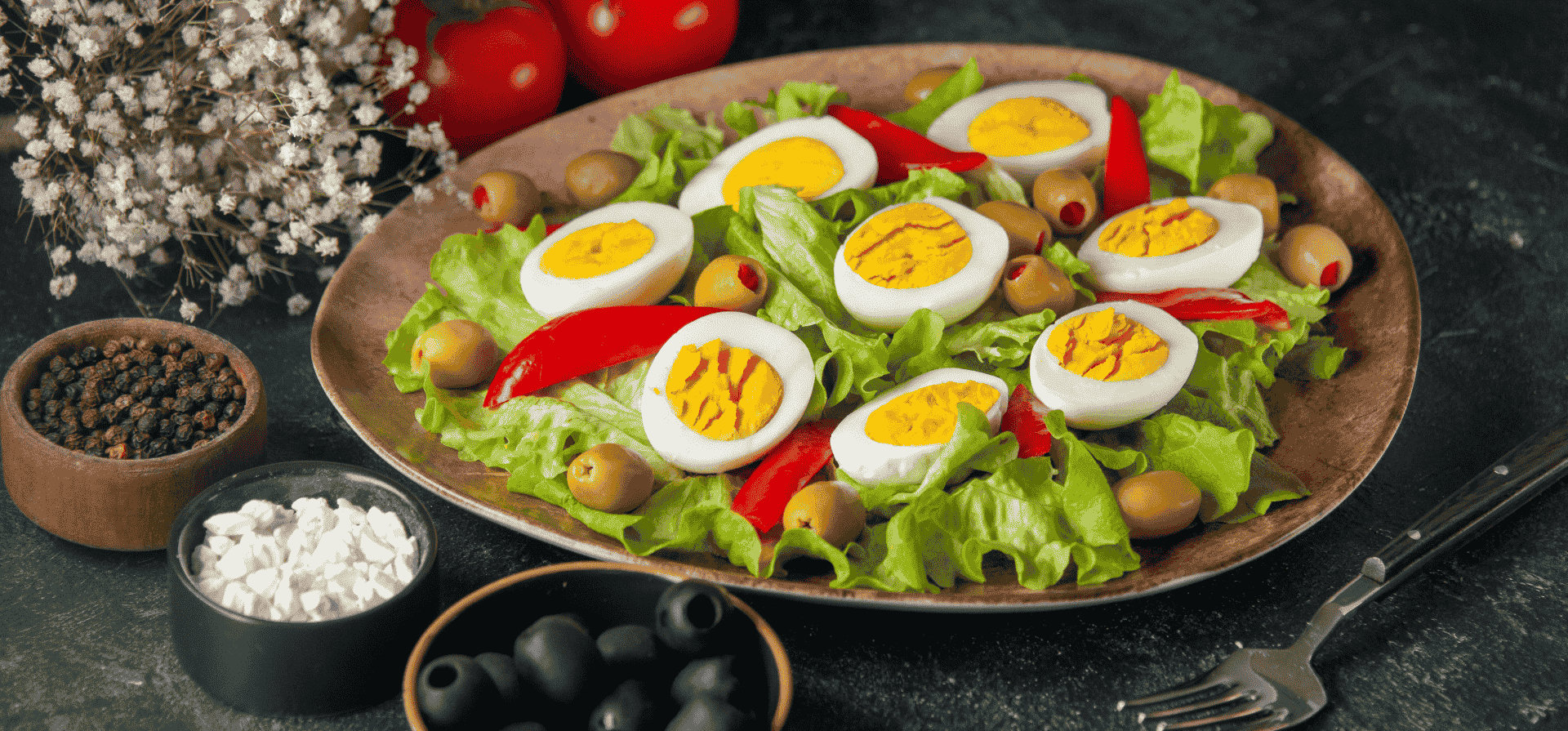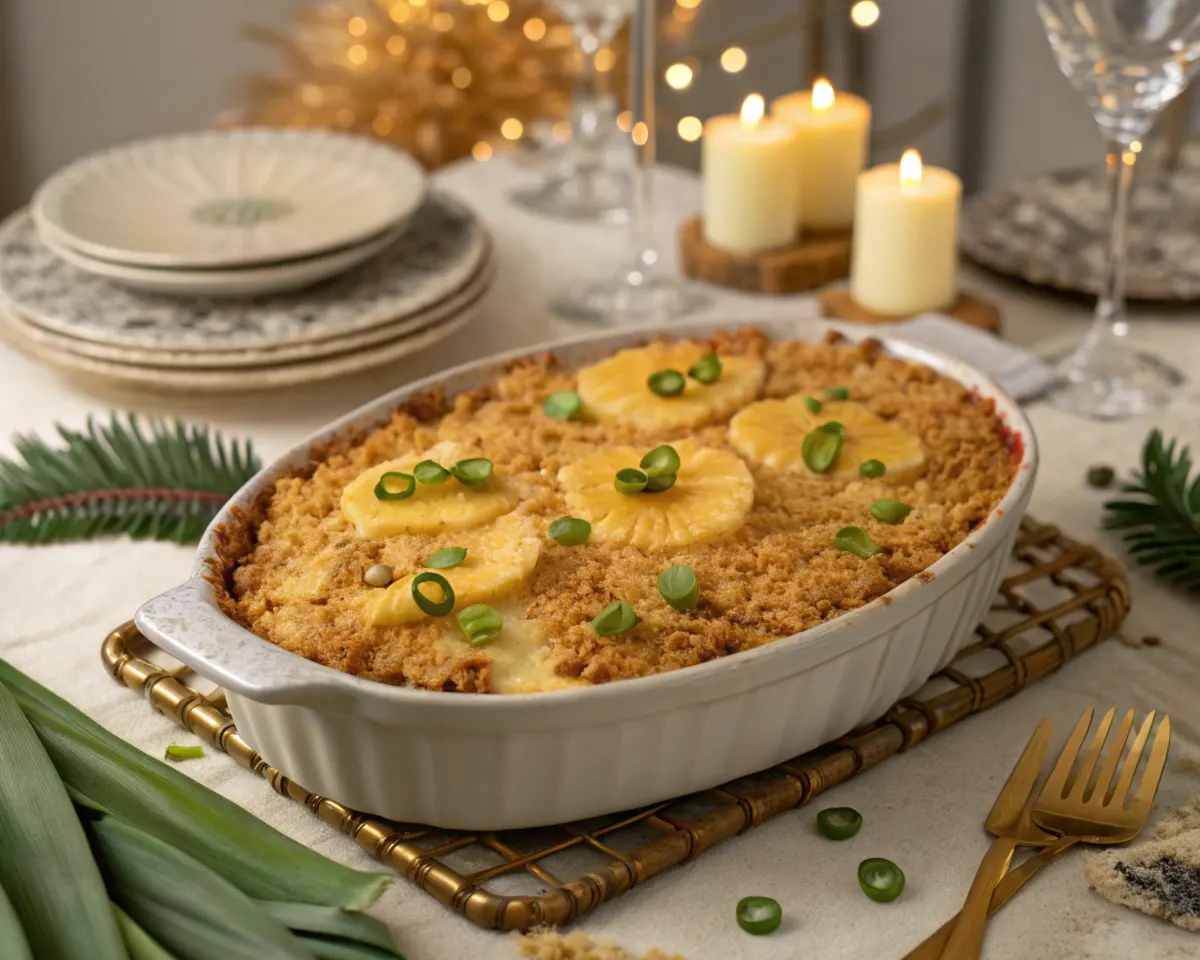Pineapple Casserole: The Ultimate Sweet and Savory Southern Classic
Pineapple casserole is a unique and delicious dish that perfectly blends sweet and savory flavors. It’s a classic comfort food often found on Southern dinner tables, making it a beloved side dish for holidays, potlucks, or just an ordinary family meal. In this article, we’ll take you through everything you need to know about pineapple casserole, from its origins and key ingredients to how to make the perfect casserole yourself. Whether you’re new to this dish or looking for ways to enhance your recipe, this guide has got you covered.
What Is Pineapple Casserole?
Understanding the Dish
Pineapple casserole may sound a little unusual at first, but trust us—it’s a crowd-pleaser! Combining the tart sweetness of pineapple with the rich, creamy goodness of cheddar cheese, this dish strikes a delightful balance between sweet and savory. The casserole is typically baked to a golden perfection, with a crispy Ritz cracker topping that adds a touch of crunch. It’s the kind of dish that surprises people—what may seem like an odd combination at first is actually a winning flavor profile!
While pineapple casserole might be unfamiliar to some, it’s a Southern classic that’s made its way into countless homes across the United States. It’s perfect for any occasion, whether you’re hosting a holiday meal or simply enjoying a cozy dinner with family. The great thing about this casserole is its versatility: It can be served as a side dish or even as a dessert, depending on how sweet you like it.
Historical Origins
The origins of pineapple casserole are a bit murky, but it’s believed to have emerged in the Southern U.S. sometime in the mid-20th century. Southern cooking has always been about combining flavors in unexpected ways, and this dish is a perfect example. The combination of canned pineapple, cheese, and buttery Ritz crackers quickly became a favorite, especially in church potlucks and family gatherings.
Over time, the dish gained popularity, and variations started popping up, with some families adding their personal twists—like a hint of cinnamon or a dash of nutmeg. While it may have originated in the South, pineapple casserole has now made its way into many kitchens across the country and beyond, becoming a comfort food staple.
Key Ingredients in Pineapple Casserole
Pineapple
When it comes to pineapple casserole, the star of the show is, of course, the pineapple itself. Most recipes call for canned pineapple chunks or crushed pineapple, which makes it easy to prepare and gives the dish its signature sweetness and tang. The canned pineapple has a syrupy liquid that blends beautifully with the other ingredients, creating a moist base for the casserole.
However, some folks opt for fresh pineapple if they want to elevate the dish a bit. While fresh pineapple may add a more vibrant and natural flavor, it can require more prep work, as you need to cut and prepare the fruit. So, for ease and convenience, canned pineapple is usually the go-to. Either way, the pineapple provides the perfect balance of sweetness, acidity, and juiciness that makes this casserole so unique.
Cheddar Cheese
Cheddar cheese may seem like an odd addition to a pineapple casserole, but it’s actually the key to balancing out the sweetness. The sharpness of the cheddar complements the pineapple’s natural sugar, creating an unexpected but delicious flavor combination. Most recipes use sharp cheddar, as it adds a deeper, more robust flavor that stands up well to the pineapple.
Some variations of the casserole might include mild cheddar or even a mix of cheddar and other cheeses, like cream cheese or gouda, to add more creaminess. The cheese melts into the pineapple, creating a rich, gooey texture that contrasts wonderfully with the crispy cracker topping.
Ritz Crackers
Ah, the Ritz crackers! These little beauties are crucial for giving the pineapple casserole its signature texture. Crushed Ritz crackers are mixed with melted butter to form a golden, crispy topping that adds the perfect crunch to each bite. The buttery crackers balance the sweetness of the pineapple and the richness of the cheddar, offering a delightful contrast in every mouthful.
The crackers also help bind everything together and create a satisfying texture that makes this casserole so much more than just a simple mix of ingredients. If you’re looking to elevate the dish, you could even add a bit of sugar to the crackers for extra sweetness.
Here’s a quick look at the key ingredients and their quantities:
| Ingredient | Quantity |
|---|---|
| Canned Pineapple | 1 can (20 oz) |
| Sharp Cheddar Cheese | 2 cups (grated) |
| Ritz Crackers | 1 ½ cups (crushed) |
| Sugar | ½ cup |
| All-purpose Flour | 2 tbsp |
| Butter | ½ cup (melted) |
Step-by-Step Guide to Making Pineapple Casserole
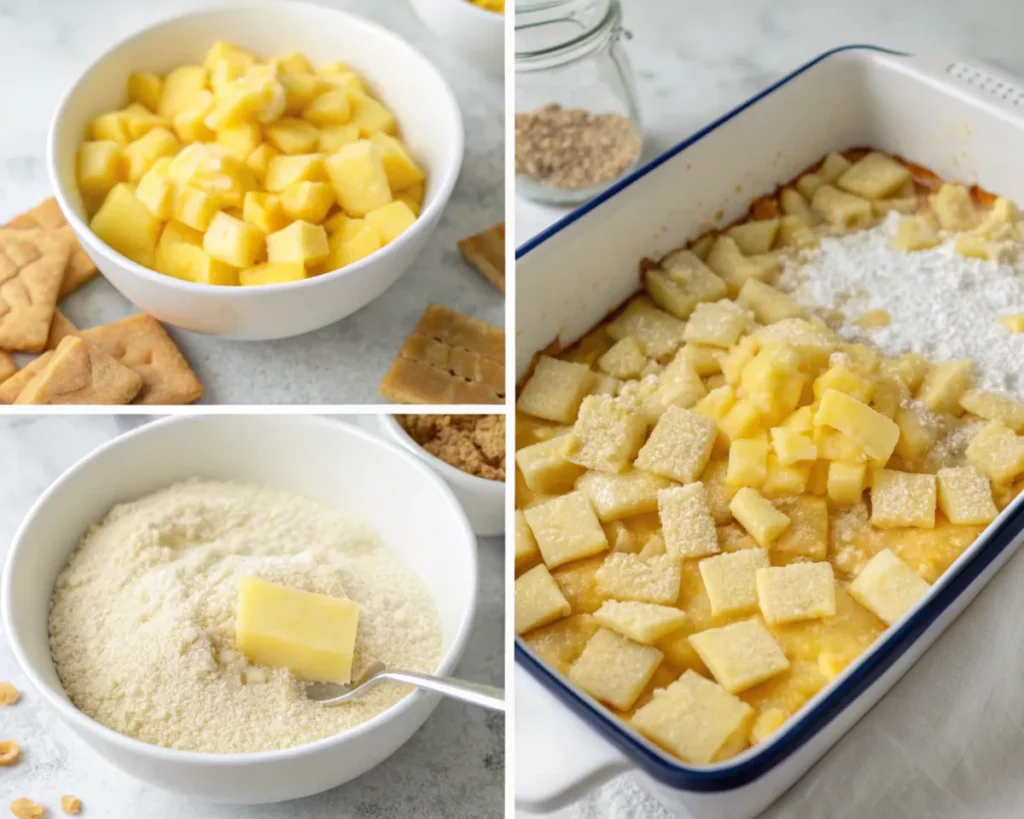
Preparation
Making pineapple casserole is simple and straightforward, which is why it’s such a popular dish for busy families and holiday meals. Start by draining the canned pineapple, making sure to reserve the juice for later use if you want to adjust the texture. If you’re using fresh pineapple, simply cut it into small chunks and set aside.
Next, combine the drained pineapple with sugar and flour in a large mixing bowl. The flour will help thicken the mixture while the sugar adds that delicious sweetness. Once the dry ingredients are mixed in, fold in the grated cheddar cheese. The cheese will melt beautifully when baked, creating a rich, creamy layer that perfectly complements the pineapple.
Topping
The topping is one of the highlights of pineapple casserole, and it’s what gives the dish its signature crunch. To prepare the topping, melt the butter in a small saucepan or microwave. Once melted, mix in the crushed Ritz crackers, ensuring that each piece is coated in the buttery goodness. You can add a pinch of salt or sugar to the cracker mixture, depending on how sweet or savory you like your casserole.
Once the cracker mixture is ready, sprinkle it evenly over the pineapple and cheese mixture in your baking dish. This layer of buttery crackers will become golden brown and crispy as the casserole bakes, providing a delightful crunch with each bite.
Baking
Now, it’s time to bake your pineapple casserole! Preheat your oven to 350°F (175°C) and bake the casserole for about 30 to 40 minutes. The casserole should be bubbling around the edges, and the topping should be golden brown and crispy. If you want a darker, crunchier top, you can broil the casserole for a few extra minutes at the end.
Once the casserole is done, remove it from the oven and let it cool slightly before serving. The texture will set as it cools, so you’ll get a beautiful contrast between the gooey cheese and the crispy cracker topping.
This pineapple casserole recipe is super simple, but the results are nothing short of amazing—sweet, savory, and perfect for any occasion! In the next section, we’ll share some tips and tricks for making sure your casserole turns out just right. Stay tuned!
Tips and Tricks for the Perfect Pineapple Casserole
Ingredient Variations
One of the best things about pineapple casserole is how customizable it is. While the classic recipe calls for cheddar cheese and Ritz crackers, there’s plenty of room for creativity! If you’re looking to experiment, you can try using different types of cheese. For example, mild cheddar will give a softer flavor, while cream cheese can add extra richness and a tangy touch. Some recipes even call for a mixture of cheeses, such as sharp cheddar combined with gouda or Monterey Jack, which creates a creamy and flavorful result.
If you’re feeling adventurous, you might also switch up the crackers. While Ritz crackers are the traditional choice, you could use any type of buttery, flaky cracker. For a slightly healthier twist, try using whole wheat crackers, or opt for a gluten-free variety if you’re catering to specific dietary needs.
Texture Enhancements
For a bit of extra texture and flavor, consider adding chopped pecans, walnuts, or almonds to the top of your casserole. These nuts add a crunchy contrast to the creamy filling and make the dish feel even more indulgent. You can either sprinkle the nuts over the Ritz cracker topping or mix them directly into the pineapple and cheese mixture.
Another great idea is to add a touch of spice! While pineapple casserole is typically sweet and savory, a dash of cinnamon or even a sprinkle of chili flakes can take it to the next level. If you like a little heat, this twist could really make your casserole stand out. Cinnamon pairs wonderfully with pineapple, while chili flakes provide a subtle kick that complements the richness of the cheese.
Serving Suggestions
While pineapple casserole is a dish that can stand alone, it pairs beautifully with a variety of main dishes. Try serving it alongside baked ham, roast turkey, or grilled chicken for a complete meal. It’s especially great for holiday dinners or gatherings because it’s both sweet and savory, which makes it versatile enough to complement a variety of meat options. For something lighter, pair it with a fresh green salad for a balanced meal.
Nutritional Information and Serving Sizes
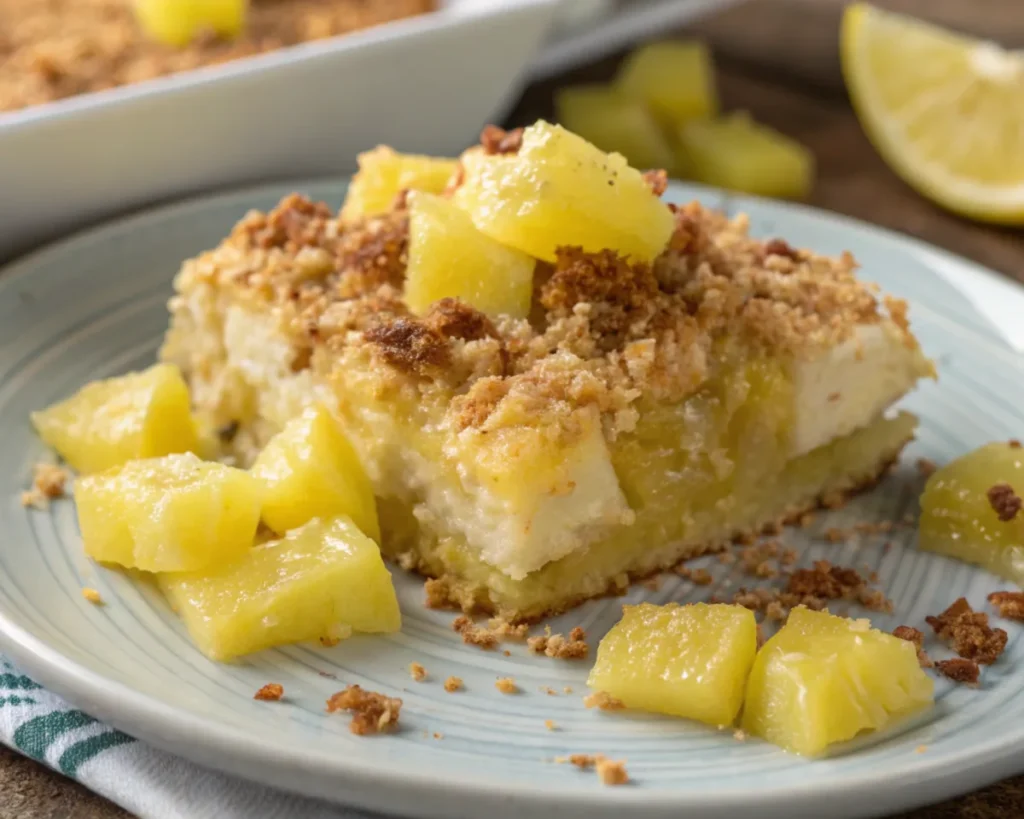
Caloric Breakdown
While pineapple casserole is undeniably delicious, it’s important to keep in mind that it’s also a rich dish. The primary ingredients—cheese, butter, and crackers—mean that it can be high in calories. On average, one serving of pineapple casserole (about ½ cup) contains approximately 200–250 calories. Keep in mind that the calorie count can vary depending on the specific ingredients used, such as whether you use full-fat or reduced-fat cheese, or if you add extra butter or sugar.
Dietary Considerations
For those looking to make a slightly lighter or more health-conscious version of pineapple casserole, there are a few simple substitutions you can try. If you’re watching your fat intake, consider using a lower-fat cheese or swapping the butter for a healthier alternative like olive oil. For a gluten-free version, simply use gluten-free crackers or skip the cracker topping altogether.
If you’re aiming to reduce sugar intake, consider cutting back on the sugar or using a natural sweetener like honey or maple syrup. However, keep in mind that altering the ingredients may affect the texture and flavor of the casserole, so it’s a good idea to experiment and adjust to your liking.
For a more balanced meal, you can serve your casserole with a protein-rich dish like grilled chicken or roast turkey and pair it with a side of steamed vegetables.
Frequently Asked Questions (FAQs)
Can I Use Fresh Pineapple Instead of Canned?
Yes, you can definitely use fresh pineapple in pineapple casserole. While canned pineapple is more commonly used for its convenience and syrupy texture, fresh pineapple can give the dish a more vibrant and natural flavor. If you choose fresh pineapple, be sure to cut it into small chunks and remove the core. Also, fresh pineapple tends to be less sweet than canned, so you might need to adjust the sugar in the recipe accordingly.
Is Pineapple Casserole a Side Dish or Dessert?
This is a great question! Pineapple casserole can be either a side dish or a dessert, depending on how sweet you make it. Traditionally, it’s served as a side dish alongside meats like ham or turkey. However, if you prefer a sweeter version, it can easily double as a dessert. The choice is yours! Some people even serve it both ways, so it can be enjoyed at any point during the meal.
How Can I Make Pineapple Casserole Ahead of Time?
If you’re short on time or want to prepare in advance, you can make pineapple casserole a day ahead of time. Simply prepare the casserole as instructed, but stop before you bake it. Cover it with plastic wrap or foil and store it in the refrigerator. When you’re ready to serve, pop it into a preheated oven and bake as directed, adding a few extra minutes if needed to ensure it’s heated through.
Can I Freeze Pineapple Casserole?
Yes, pineapple casserole can be frozen! To freeze, allow it to cool completely after baking, then cover it tightly with plastic wrap and aluminum foil. When you’re ready to enjoy it, thaw it overnight in the refrigerator, then reheat it in the oven at 350°F (175°C) for about 20-30 minutes. The topping may lose a bit of its crunch after freezing, but it will still taste delicious.
What Are Some Variations of Pineapple Casserole?
There are many variations of pineapple casserole to try! Some people add shredded coconut for a tropical twist, while others like to mix in marshmallows for a fun, sweet surprise. You can also experiment with adding nuts like pecans or walnuts for extra crunch, or even spice things up with a touch of cinnamon or nutmeg.
Exploring Variations of Pineapple Casserole
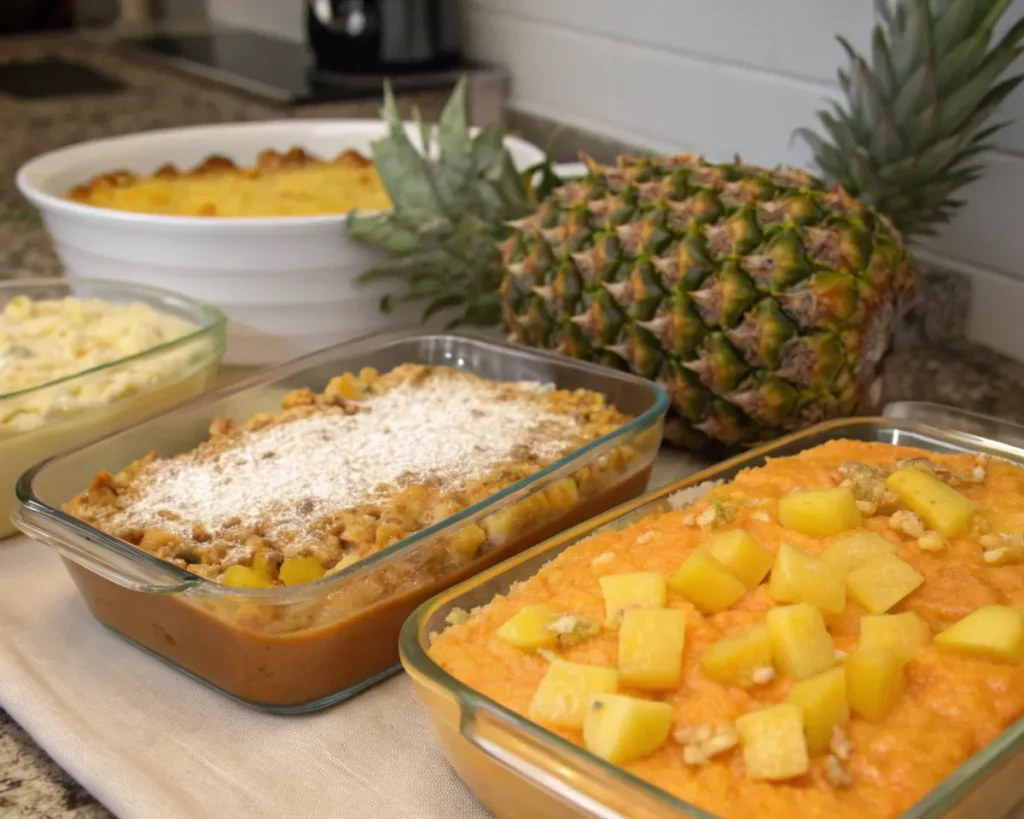
Sweet Potato Pineapple Casserole
If you’re looking for a hearty variation of pineapple casserole, try adding sweet potatoes. This twist combines the creamy texture of mashed sweet potatoes with the sweet and tangy pineapple, creating a perfect balance of flavors. To make this version, simply add cooked mashed sweet potatoes to the pineapple mixture before baking. It’s an excellent way to add more nutrition and a comforting, fall-inspired flavor to the dish.
Pineapple Casserole with Coconut
For a more tropical version of pineapple casserole, try adding shredded coconut to the mix. Coconut adds a slightly nutty and chewy texture that complements the pineapple beautifully. You can stir the coconut into the pineapple mixture or sprinkle it on top along with the cracker topping. It’s a simple way to elevate your casserole and give it a summery flair.
Spicy Pineapple Casserole
If you’re a fan of spicy food, you might want to try a spicy version of pineapple casserole. Add a little jalapeño, chili flakes, or even Cajun seasoning to the dish for an unexpected kick. The heat from the spices balances well with the sweetness of the pineapple and creates a truly unique flavor profile. This variation is great for those who like a bit of spice with their comfort food.
These variations of pineapple casserole prove that the dish is not only versatile but also adaptable to different tastes and occasions. Whether you prefer something tropical, spicy, or extra hearty, there’s a pineapple casserole for everyone!

